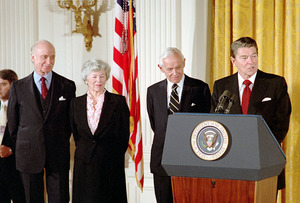Roberta Wohlstetter facts for kids
Roberta Morgan Wohlstetter (born August 22, 1912 – died January 6, 2007) was an American historian. She studied how the U.S. military gathers and uses information. In 1962, she wrote a very important book called Pearl Harbor: Warning and Decision. This book looked closely at the Japanese attack on Pearl Harbor in December 1941. It is still seen as a key study of how military surprises happen. In 1985, President Ronald Reagan gave her the Presidential Medal of Freedom, a very high honor.
Contents
Early Life and Education
Roberta Mary Morgan was born in 1912 in Duluth, Minnesota. Her father, Edmund Morris Morgan, was a professor at Harvard Law School. He helped make federal laws simpler and updated the U.S. military laws. Her brother, Edmund Morgan, was also a historian who won a Pulitzer Prize.
Roberta Wohlstetter earned her first degree from Vassar College in New York in 1933. She then earned two master's degrees. One was in psychology from Columbia University in 1936. The other was in comparative literature from Radcliffe College in 1937.
Her Career and Contributions
From 1948 to 1965, Wohlstetter worked for the RAND Institute. This is a research group that helps governments make important decisions. She continued to advise RAND as a consultant until 2002.
In 1963, she won the Bancroft Prize in American History from Columbia University. This award is given for excellent books on American history.
Wohlstetter also taught at several universities, including the University of Chicago, Barnard College, and Howard University. She gave talks at many other colleges too. She was a member of important groups like the Council on Foreign Relations. She also advised the Assistant Secretary of Defense for International Security Affairs. President John F. Kennedy even asked her for advice during the Cuban Missile Crisis.
Her Book: Pearl Harbor: Warning and Decision

As part of her work at the RAND Corporation, Roberta Wohlstetter researched why the U.S. was surprised by the Japanese attack on Pearl Harbor in 1941. She published her findings in her 1962 book, Pearl Harbor: Warning and Decision.
To write the book, she studied the official hearings held by the American Congress after the attack. These were published in 1946. She also read the memories of Japanese and American leaders and military commanders. She even interviewed people who were part of the U.S. Navy and U.S. Army during that time.
Her book explains why U.S. intelligence failed to predict the attack. Before 1941, U.S. code breakers were reading many secret Japanese messages. However, the attack still came as a complete surprise.
- Why the surprise?
- Big Picture (Strategic) Surprise: U.S. experts thought Japan wouldn't attack because they couldn't win a long war against the U.S. (Actually, Japanese planners hadn't fully thought through winning the war. They just wanted to expand and saw the attack as the best way to start a conflict.)
- Repeated False Alarms: In 1940-1941, U.S. forces were put on high alert several times, but no attack happened. This made people less alert over time.
- Wrong Location: Many believed that if Japan attacked, it would be in the Philippines, not Pearl Harbor.
Wohlstetter's book argues that intelligence failures can happen even with lots of information. It's hard to find the important "signals" (true warnings) hidden in all the "noise" (other facts and distractions).
On a smaller, more immediate level (tactical surprise), the attack was a surprise because warning systems like radar stations and patrol planes were not fully used. Leaders thought they were, but they weren't.
How the Book Influenced Others
Many experts have praised Pearl Harbor: Warning and Decision. Military history writer Eugene Rasor called it "the best and most complete study of the intelligence failure" that led to the attack.
The book became important again after the al-Qaeda attacks on the World Trade Center and the Pentagon on September 11, 2001. Donald Rumsfeld, who was the Secretary of Defense at the time, was greatly influenced by the book. He even asked his assistants to read it before 9/11 happened.
In 2013, a new book called Constructing Cassandra updated Wohlstetter's ideas. It showed that how intelligence "signals" are found from "noise" depends on the culture and way of thinking of the intelligence group.
Presidential Medal of Freedom

Roberta Wohlstetter and her husband, Albert, both received the Presidential Medal of Freedom from President Ronald Reagan in 1985. This is the highest civilian award in the United States.
President Reagan said that Roberta Wohlstetter was "a generation ahead of her time." He noted that she made a big impact in areas often led by men. He said she overcame challenges and had a deep influence. Her studies looked at important questions about society, terrorism, and how to get warnings. Her work, and her husband's, on preventing nuclear war, created new ideas for leaders. Reagan joked that she probably asked her husband tough questions, which helped him write clearly about strategy and world events.
Personal Life
In 1939, Roberta Wohlstetter married Albert Wohlstetter. He was a mathematician and an expert on nuclear strategy. She had one daughter, Joan Wollstetter-Hall.
Roberta Wohlstetter passed away on January 6, 2007, at New York Hospital in New York City. She was 94 years old.


